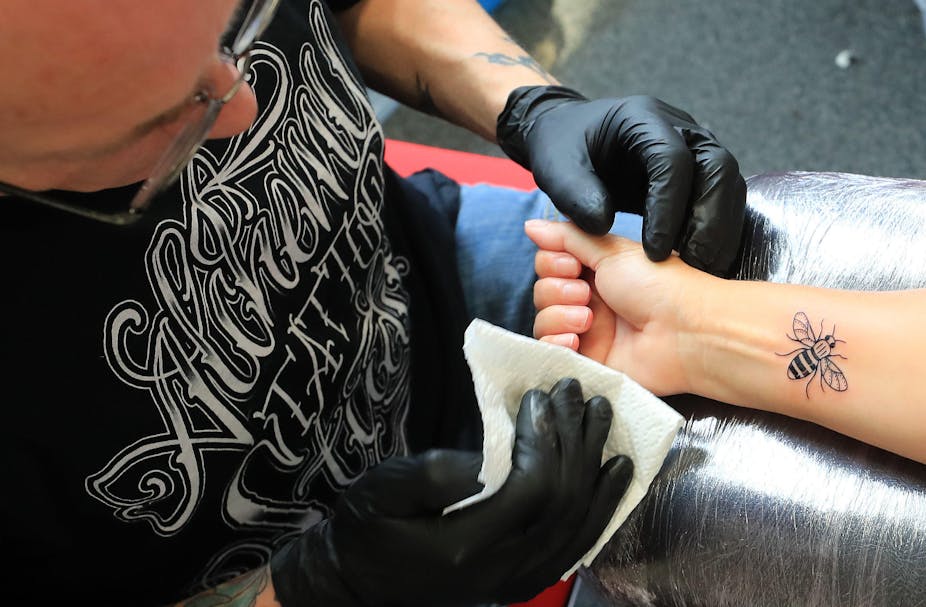Few things divide us like tattoos. Tell someone you research tattoos, as one of us (Steph) does, and their eyes will often wander, searching for inked designs on your body before compulsively sharing their views.
Steph’s research looks at the assumptions that people in the UK make about those with tattoos – their jobs, class, history and competence. For example, the notion of a vicar with a tattoo is still shocking to many people.
Despite the big rise in the popularity of tattoos – a YouGov poll in August 2022 found that more than 25% of Britons have them – some people (and researchers too) still associate them with deviant personalities. Equally, many may see them as mere fashion accessories with no significance beyond the aesthetic.
But what people may overlook is that tattoos are often about connection to local culture, unity and collective identity.

And that’s not just the case for places often considered to have a strong cultural link with tattooing, such as Polynesia, whose famously intricately designed tattoos have recorded origins stretching back to 2000BC.
The UK also has its own history of tattoos interlinked with places and communities. And that history is still evolving.
Growing up in Birmingham in the 1970s, Steph was not aware that there were any historical Birmingham-inspired tattoos beyond the local football teams. But recent civic pride has seen a growth of Black Country chain tattoos, represent the manufacturing heritage of the area, and tattoos of a bull, a symbol of Birmingham.
Some surveys suggest Birmingham is the most tattooed city in England, with 48% of locals sporting at least one tattoo, and six tattoos the average for those who are inked. The same data also shows locals in Norwich and Glasgow are heavily inked too.
But the regional status of tattoos isn’t just about how common they are. It can relate to a certain aesthetic with a meaning linked to the local area. And often it’s about people categorising themselves to reinforce a sense of community or form a sense of identity.
Perhaps the most recognisable regional tattoo in recent years is the Manchester bee. Representing hard work, defiance and commemoration, the bee has gained global recognition and brought people together following the 2017 Manchester Arena bombing in a way that badges and wristbands could not.
Tattoos can also be a form of secret communication known as steganography. They show hidden messages within other information, a code that is meaningless to outsiders who just “see” the image without knowing the meaning that is in plain view.
For example, the Pompey dot tattoo (one to five dots on the back of the hand, between thumb and forefinger) marks the wearer as being from Portsmouth. It’s an exclusive brand for those “in the know”.
If you’re not with us, you’re against us
Tattoos can also be about telling people, “You’re not one of us.” Football fandom, and hometown allegiances all show proud kinship that veers into this territory.

Take, for example, Millwall FC, whose emblem is a lion. Millwall’s reputation is that “no one likes us” and, for some fans, wearing body art depicting the lion is as much a part of fandom as attending matches. The sense of unity in being disliked becomes its own cohesive in-group.
Millwall’s tattoos work in two ways: the lion is a fierce in-group symbol, while the proud chant, “No one likes us / We don’t care,” reinforces the barrier between members and the rest of the world (the out-group).
Notorious football fans Chelsea Headhunters show off their tattoos in online galleries. Like Millwall, they are widely disliked, due to their historic links to white supremacist groups such as the National Front, Combat 18 and paramilitary outfits. Tattoos are a way of belonging, yet at the same time, not belonging to wider society.
Ancient roots
If you follow the tendrils of tattoo history back far enough, their association with defiant out-groups is historical. Evidence of ancient tattooing has been found throughout Egypt, where it was mostly the preserve of concubines and dancers wearing the symbol of protector goddess Bes.
Around 1050BC, before the Phoenicians invented the alphabet that would become the basis of many modern scripts, Phoenician craftsmen such as stone-cutters or rope-makers would tattoo images depicting their skills on their skin as a kind of CV to display their trades.
People no longer need to advertise their trades and skills on their skin, and instead choose to show allegiances and identities. Now, flag tattoos of nations, sexuality and genders have become a kind of social CV.
Many gay communities sport tattoos that go beyond the traditional rainbow. The leather pride and bear brotherhood flags serve dual purposes. They are recognisable to those in the know, yet impenetrable to those who are not (who may wish the wearer harm).

However, modern tattoo tribalism is sometimes driven by fads. The popularity of the Celtic knot or band tattoo in the 1990s has waned. At its peak it was the fashionable tattoo-of-choice, with many wearers sporting it for the aesthetics and fashion, yet they didn’t understand its meaning and historical significance as a source of (tribal) pride for non-English wearers.
Despite this, the idea of outsider groups using tattoos as catalogues of deviancy still persists. As one tattooed participant in Stephanie’s research told her: “We’re not all prostitutes and prisoners are we?”
Similarly, another tattooed participant said: “I don’t think I’ve ever met a person with face tattoos who has their life together… that’s a remnant of prejudice … passed down to me by the generation above.”
They may have a divisive history but tattoos are a visual language that can unify people, depending on if the users wish to expose or hide their allegiances.

